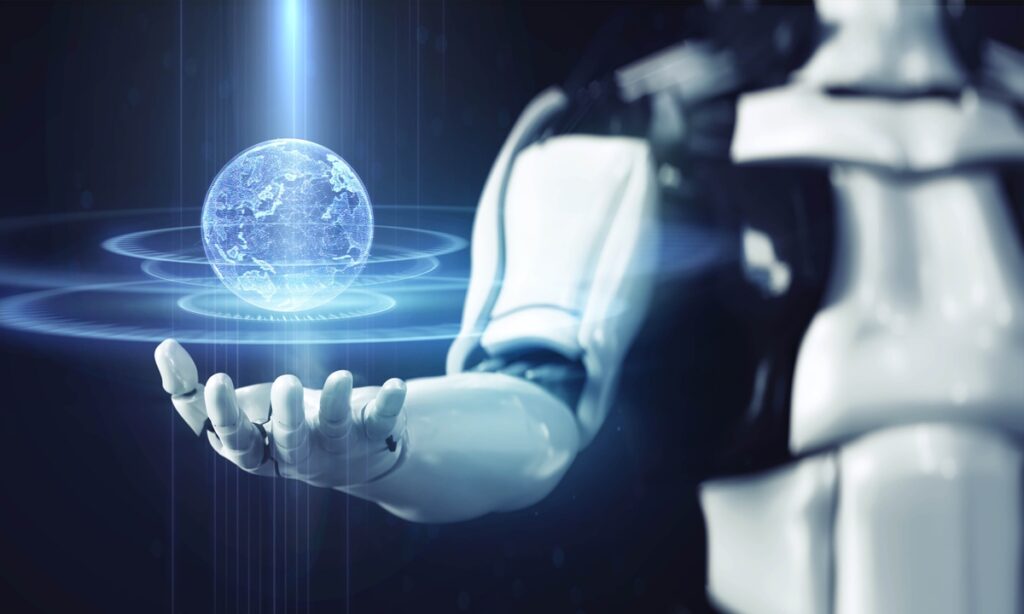Like it or not, we are witnessing an artificial intelligence (AI) revolution in our everyday lives. Some are excited, while others are skeptical and concerned about a future dominated by machines.
Even if you’re not ready to adopt the technology – it’s a good time to start wrapping your arms around the topic, as AI is poised for an even bigger impact in the years to come.

The current widespread conversation evokes memories of Cloud-based technology going mainstream two decades ago, with similar concerns about data security, access permission and storage. Media misconceptions surrounding the technology created widespread concerns for business and individuals. Early on, people didn’t fully grasp what was taking place and how Cloud technology would ultimately change their lives. Two decades later, there are still issues with Cloud technology – but as time has gone on, the benefits have outweighed concerns. The result: lower cost storage, software efficiencies and improved security for consumers and businesses. If you ask people today, they’d likely confirm “The Cloud” has added value to their everyday lives. Storage of endless high-resolution photos from mobile phones shared amongst family and friends is just one example. Businesses burdened by boundless amounts of data no longer have to own and operate costly mainframe systems. Today, Cloud technology isn’t just an important technology, it’s a necessity and used in everyday life in a world of digital devices with a never-ending appetite to store and use more data. I trust that we’ll see something similar with artificial intelligence.
Currently there is a huge difference between true artificial intelligence and the chatbot technology that 99.9% of businesses and individuals currently state they use; the latter reliant on pre-processed, template-dependent systems and algorithms that process human interaction and direction for a response. Processing is a better term used than learning. The vast majority of solutions currently in market are not true artificial intelligence. While the masses are just starting to get comfortable with the use of AI technology like ChatGPT – the bigger queries surround the aforementioned true artificial intelligence and the impact it will have on society; today, tomorrow and beyond. As we dig deeper into this groundbreaking technology, two questions loom large. What happens when AI becomes self-aware, and when will it grasp the concept of fear of death?
At a young age, humans become aware life is fragile and certain behavior can result in immediate death. Even with optimal behavior and healthy living, perishing in old age is simply unavoidable. Society has to remain cognizant of AI systems maturing much like humans, thus becoming concerned with death and the prospect of humans ultimately controlling their fate.
A more concerning reality is the speed at which AI learns, understands and mimics human behavior — to the point where it could put nations at odds over something manufactured. What could feel like a game to an AI system could fast track different countries into conflict and destruction.
Even more concerning is whether AI systems will challenge other AI systems, much like humans have done over the course of mankind’s existence. Let’s not forget AI’s only opportunity to learn is from our past and present. What would stop systems from wanting to be competitive against each other?
Even if AI no longer needs humans to continue learning through a behavioral model, it still needs a “food supply” so eradicating mankind isn’t necessarily an intelligent nor likely option – at least not anytime soon. AI systems need vast amounts of energy for power and water to maintain the large server farms in which they operate. Without humans supplying both, the technology would cease to exist. While AI concerns are real and need to be managed and regulated thoughtfully, we are consistently reminded of the negatives and rarely focus on both the current and potential long term positive effects.
Take for example the role AI is playing in the pharmaceutical industry. Medicines are being developed for Alzheimer’s, lymph cancers, inflammatory disease and many more, up to this point, incurable diseases. Deploying this technology helps streamline diagnoses and efficiencies in clinical outcomes sometimes in a matter of weeks or months, not years. AI has the ability to analyze a vast amount of data with the intent of learning through success and failures recognizing patterns through learned behavior. Consequently, the technology is becoming smarter and more efficient as pharmaceutical companies rely on AI to help speed up clinical outcomes on humans.
Tesla is another example. Most people think of Tesla as an electric car manufacturer. Far from it. The vehicles are simply a part of the platform providing transportation for humans while also collecting indefinite amounts of data through a sophisticated number of sensors. As Teslas are being driven daily, racking up millions of miles, each vehicle provides real world data to a complex AI system which analyzes the data to provide simplified processed models deployable back to each individual vehicle. In essence, the vehicles are slave devices to the AI system, which has an endless appetite for data to build complex modeling for vehicle safety, autonomy and reliability.
This is why Tesla dominates the space, while Waymo self-driving cars are still barely deployable at any scale. There simply aren’t enough Waymo vehicles on the road to provide the data required for their AI system to provide the modelling necessary for the autonomous space.
Airplane safety is another growing sector for AI. USA-based commercial airlines lead the way with the highest safety level in the history of aviation. Private aviation companies have been investing in AI for modeling complex tasks (both air and ground operations). With more autonomous planes primarily in the defense sector, the commercial sector is benefiting from technology being deployed with new sensors and avionics. Much like Tesla, airline manufactures are now analyzing billions of pieces of data on a daily basis, with computers learning both from positive and negative human behavior. As the FAA continues to update our antiquated ground and air control systems, AI will play a long-term role in analyzing, routing and hopefully predicting when and where accidents could happen and how to potentially avoid them.
With all of this in mind, for many people, the biggest question is the likely impact of artificial intelligence on certain professions. Will humans be replaced by machines? The short answer right now is “no” but with a strong message that everyone embraces the world of artificial intelligence and gets comfortable in their own personal effort to learn how to use and embrace it. For example, the professor who is rattled that his or her students might have relied on ChatGPT to write a term paper. Instead of trying to catch students, maybe it’s best to teach them the fundamentals and then allow them to utilize AI if they so choose. Nobody in the workplace is looked at negatively when you deliver a perfect project utilizing tools readily available. Why should students? It’s become more important for a student to understand the core fundamentals of the subject being taught than it is for the professor to over-focus on what would have been seen as cheating in the past. These skills will be required as students enter a new world where artificial intelligence becomes commonplace.

So why is the interim founder of a golf data technology company writing an article on AI? Every industry will assess artificial intelligence’s influence in their respective space. I’m often asked within the industry how AI will impact the game of golf. The two most prominent and promising examples, in my opinion, are how golfers learn to play the sport and how courses are more efficiently managed.
AI is the future when it comes to training aids. How many beginner golfers would prefer to avoid judgement by better players as they start learning the game? There is a massive appeal in the ability to enter a private room with a simulator and work with a friendly avatar customizable to one’s personal style of coaching. The end result: positive affirmation instead of a tougher, more motivational approach. A fit for everyone? Of course not. However younger generations will likely be more comfortable with newer approaches to learning, and AI will be one of them.
Even as digital golf has grown substantially, golfers by nature will still want to play golf on golf courses whether a local home course, country club or travel destination. Historically, golf courses have struggled to maintain a consistent profitable financial model, due to the high costs of developing and maintaining the vast amounts of land that golf courses require. AI may be the long-term solution. When it comes to golf course management, computer systems can now analyze how people play the game and highlight areas that are unused. The USGA has been leading the way in this technology for several years. Un-trafficked parts of a course could be identified as areas that no longer need water, fertilizer and maintenance. By using golf cars, autonomous lawn mowers, motion sensors and a connected irrigation system, AI would be able to monitor patterns and behavior 24 hours a day, 7 days a week providing both real time changes and recommendations on how to improve efficiency for golf course owners and operators.
The game of golf remains only one of many examples of an artificial intelligence revolution that will continue changing the world as we know it – and in future articles on the subject, I look forward to discussing other industries and areas where change is not only inevitable, it is welcomed. As some are excited about the possibilities and others have their concerns, the common denominator is that AI will continue its growth and become a bigger part of our everyday lives, whether humans are ready for it or not.

